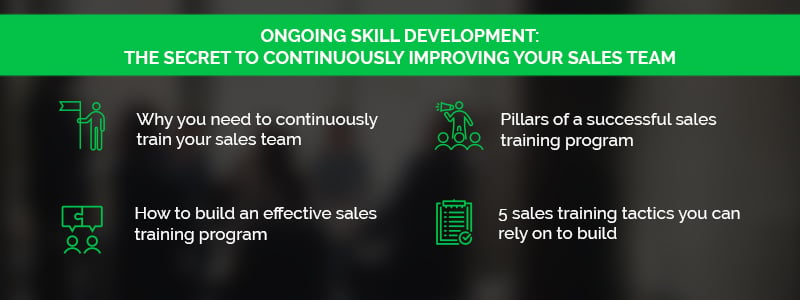Ongoing Skill Development: The Secret to Continuously Improving Your Sales Team

In your quest to make your company bigger, better, and ultimately more successful, you can’t leave your sales team as it is right now.

Sales training (and hiring) should never end. Do you know why? Because these are activities that deal with people. People evolve, and your sales team should too.
There will always be newer, better techniques and scripts to make your salespeople more effective at their jobs. And a hallmark of a company that has its priorities straight is the willingness and ability to make sure its sales team remains on the cutting edge.
Why you need to train your sales team
This scenario is so common it should be made into a Hollywood movie. A company starts out and the founder or CEO takes charge of the sales himself. He leads a small, close-knit team of handpicked lieutenants to evangelize about the virtues of the product and the vision that drives the new company.
Growth happens, and the sales team goes from 0 to 1 to 2 — sales training is easy and straightforward as you lead by example and your colleagues follow diligently. Additions to the team? No problem. They just look at what you do and learn how to find leads, set appointments, handle sales calls, and overcome objections.
And then you reach a tipping point. Your business starts to scale. All that hard work in the sales department and other areas has begun to pay off exponentially.
You find yourself pulled in several different directions at once. You no longer have as much time to give to the sales department, so you bank on the people who learned from you to keep the ball rolling. You even appoint someone else to take over your former role.
But it’s not the same. Cracks start to show in your edifice. After all, there is no blueprint to ensure and coordinate proper training, no metrics to measure mastery or progress.
Just when you begin to think things could not get any more precarious, you bring in new recruits and find out they have no support and no onboarding to show them what the expectations are. Before you know it, your vision gets shunted to the side as your sales department morphs into a parody of what the original vision was.
And the worst part of this entire scenario is that it is all your doing.
As founder/CEO and former head of sales, the responsibility for making sure your sales department (the very lifeblood of your company) has everything it needs to be successful lies squarely at your feet.
Relying on word of mouth to pass on your vision and strategies is simply not going to cut it once your company starts growing. And neglecting to leave in place documented sales training processes and techniques would eventually start a slow, steady decline into the sales free-for-all you do not want to see.
The solution to breaking out of this scenario and “founder selling” in general, where you finally decide to retake the reins and risk stunting growth in other areas, is to provide training resources that salespeople can easily digest and execute. This is an ongoing process, so the team grows with the changing needs of the company and the people it serves.
How to build an effective sales training program
Being an effective salesman is harder today than it has ever been. Not only should your sales team be versed in your offerings, but they also have to be knowledgeable about the industry in which your customers operate.
In addition to that, buyers have become more sophisticated and will not settle for any run-of-the-mill generic pitch designed to get a foot through the door.
Effective sales training should give your sales team the knowledge and resources needed to become credible partners to customers during the sales process.
Here are the components of a great training program:
The 3 pillars of a successful training program
1. Interactive sessions
Interaction is difficult to deliver because of the complexity and skill that is required for design and implementation. However, your sales training program could use a little creativity to go beyond talking heads to ensure salespeople connect and interact with their instructors.
A few ways to incorporate interactivity include:
- Brainstorming
- Sharing experiences
- Situational games or exercises
- Roleplaying
Even exercises as simple as asking each salesperson to make pitches for the others to give feedback on could be vital.
2. Interdepartmental connections
Successful selling goes beyond the sales department to include marketing and product development. The best sales programs break down silos and bring these departments together as a means of fostering connections and collaborations for better results. For example, you could ask the marketing department to share their content and ideas or invite the product teams to talk about their products and give insight.
3. The customer perspective
Nobody gives insight into the customer journey better than customers themselves. So, it makes good sense to bring them in for sales training. You want to be grounded in realities rather than assumptions. Real customer interaction allows salespeople to learn what customers think about the product, how they use it, and the challenges they have been facing with it.
5 sales training tactics you can rely on to build a strong sales team
Once the three pillars for a successful sales training program are in place, you can proceed to implement these five tactics:
1. Define objectives and key performance indicators (KPIs)
The first thing to do is identify the objective of your training: increase quotas, reduce sales cycle times, more closes, and so on. Then, create materials and training sessions designed to boost these metrics. One advantage of this approach is that you can easily measure impact and progress.
2. Zero in on performance gaps
Identifying performance gaps regularly will ensure your efforts are never misdirected. A drop in performance in any area should trigger new or refreshed training to quickly get back on track.
3. Design your training with a long-term view
Ensure that the idea of training as an ongoing process is embedded into the DNA of the sales department. Then go on to provide regularly updated materials to help with the continuous learning process.
4. Improve retention
Make sure your training doesn’t go in through one ear and out the other! Use proven techniques to boost retention, such as:- Regularly updating materials
- Frequently assessing knowledge levels
- Coaching
5. Incorporate feedback
Constantly ask for feedback to ensure that your training is actually helpful and to learn how it can be improved. Anonymous surveys are one way to get this feedback.
Implementing a sales training program the right way is an investment that will keep paying dividends over and over as your business grows and evolves.
Scratching your head over sales?
MetaGrowth is a consultancy dedicated to helping founders and CEOs build winning sales teams that grow their companies and revenues. If you’re currently wondering how to grow your sales team or improve its performance, contact MetaGrowth today.
Written by
Joe Arioto
